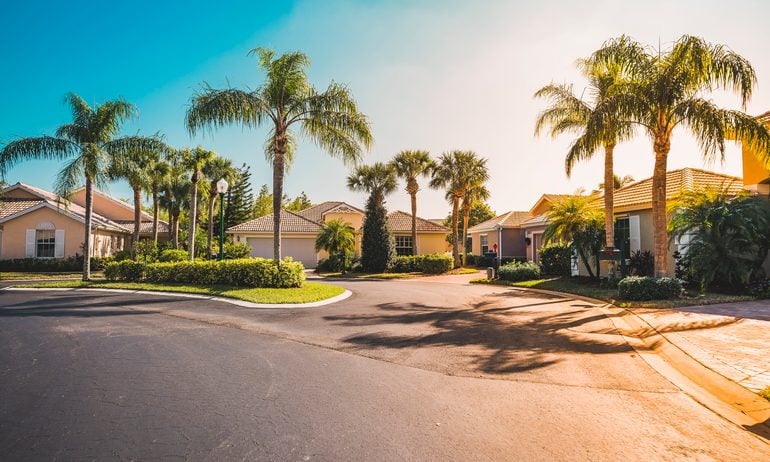Flood Insurance in Florida: Cost and Coverage Guide
Even Floridians who don’t live near the beach may want to consider buying flood insurance.

Many, or all, of the products featured on this page are from our advertising partners who compensate us when you take certain actions on our website or click to take an action on their website. However, this does not influence our evaluations. Our opinions are our own. Here is a list of our partners and here's how we make money.
The average cost of flood insurance in Florida is $865 per year for a policy from the National Flood Insurance Program.
Your mortgage lender or insurance company may require you to have flood insurance.
Flood insurance in Florida covers damage from scenarios such as storm surge and overflowing rivers.
Hurricanes, tropical storms and rising sea levels make Florida one of the country’s most flood-prone states — and you don’t have to live near the beach to be at risk. That’s why you may want to consider buying flood insurance in Florida, regardless of where you live in the state.
Do you need flood insurance in Florida?
Whether you’re required to buy flood insurance in Florida depends on your insurance company and where you live. If you have a mortgage and your home is in a “Special Flood Hazard Area” (SFHA) as designated by the federal government, your lender will likely require you to buy flood insurance.
An SFHA has at least a 1% chance of flooding in a given year. You can check whether your home is in one of these high-risk flood zones on the Federal Emergency Management Agency’s website.
If you live in an SFHA and have ever received federal disaster assistance for a previous flood at your address, you must maintain flood insurance to be eligible for future federal aid. This requirement applies even if the assistance went to a previous owner of your home.
By law, home sellers in Florida must tell potential buyers whether they’ve ever filed a flood insurance claim or received federal assistance for flood damage to the property.
Don't live in an SFHA? You may still be required to buy flood insurance if you have a homeowners policy from Citizens Property Insurance Corp. Citizens is Florida's insurer of last resort.
State law requires anyone with a residential Citizens policy that includes wind coverage to buy flood insurance if the dwelling coverage limit on their policy is $500,000 or more. Those with lower dwelling coverage limits will need to get flood insurance by the following deadlines:
Jan. 1, 2026: Homes with dwelling coverage of $400,000 or more.
Jan. 1, 2027: All other insured homes.
Citizens policyholders whose homes are in an SHFA must also have flood insurance, regardless of their dwelling coverage limit.
This law doesn’t apply to condo owners insured with Citizens, or those who have policies without wind or hail coverage. These policyholders can choose whether they want to buy flood insurance.
Even if flood insurance isn’t required for your property, it might still be smart to have it. About 40% of flood claims to the National Flood Insurance Program come from people who live outside of SFHAs. You can check your property’s risk by entering your address at FirstStreet.org. First Street is a private company that models various climate risks.
» MORE: Do I need flood insurance?
How much is flood insurance in Florida?
The average cost of flood insurance in Florida is $865 per year, or about $72 per month, for a policy from the federally funded National Flood Insurance Program. The NFIP is Florida’s largest flood insurance provider. Your flood insurance rate will depend on factors such as your home’s elevation and proximity to water sources.
Cost of Florida flood insurance by county
Below is a breakdown of average flood insurance cost by county. These rates show only the cost of NFIP policies, including commercial properties, and don’t include private flood insurance rates.
County | Average annual cost | Average monthly cost |
|---|---|---|
Alachua | $636 | $53 |
Baker | $798 | $66 |
Bay | $483 | $40 |
Bradford | $897 | $75 |
Brevard | $640 | $53 |
Broward | $558 | $46 |
Calhoun | $1,054 | $88 |
Charlotte | $1,574 | $131 |
Citrus | $1,799 | $150 |
Clay | $822 | $69 |
Collier | $1,082 | $90 |
Columbia | $783 | $65 |
DeSoto | $967 | $81 |
Dixie | $1,425 | $119 |
Duval | $758 | $63 |
Escambia | $726 | $61 |
Flagler | $720 | $60 |
Franklin | $1,924 | $160 |
Gadsden | $758 | $63 |
Gilchrist | $920 | $77 |
Glades | $742 | $62 |
Gulf | $1,298 | $108 |
Hamilton | $836 | $70 |
Hardee | $1,147 | $96 |
Hendry | $992 | $83 |
Hernando | $1,412 | $118 |
Highlands | $518 | $43 |
Hillsborough | $1,281 | $107 |
Holmes | $924 | $77 |
Indian River | $879 | $73 |
Jackson | $871 | $73 |
Jefferson | $679 | $57 |
Lafayette | $893 | $74 |
Lake | $665 | $55 |
Lee | $1,379 | $115 |
Leon | $823 | $69 |
Levy | $1,773 | $148 |
Liberty | $765 | $64 |
Madison | $773 | $64 |
Manatee | $1,184 | $99 |
Marion | $588 | $49 |
Martin | $762 | $63 |
Miami-Dade | $584 | $49 |
Monroe | $1,905 | $159 |
Nassau | $726 | $60 |
Okaloosa | $585 | $49 |
Okeechobee | $816 | $68 |
Orange | $558 | $46 |
Osceola | $565 | $47 |
Palm Beach | $528 | $44 |
Pasco | $1,274 | $106 |
Pinellas | $1,296 | $108 |
Polk | $595 | $50 |
Putnam | $990 | $83 |
Santa Rosa | $715 | $60 |
Sarasota | $1,132 | $94 |
Seminole | $662 | $55 |
St. Johns | $777 | $65 |
St. Lucie | $566 | $47 |
Sumter | $555 | $46 |
Suwannee | $945 | $79 |
Taylor | $1,722 | $143 |
Union | $866 | $72 |
Volusia | $573 | $48 |
Wakulla | $1,834 | $153 |
Walton | $494 | $41 |
Washington | $919 | $77 |
Cost of Florida flood insurance by city
Below is the average cost of flood insurance in some of Florida’s largest cities. This data is for all NFIP policies, including commercial policies, and does not reflect the average rates for private flood insurance.
City | Average annual cost | Average monthly cost |
|---|---|---|
Boca Raton | $595 | $50 |
Bradenton | $1,069 | $89 |
Cape Coral | $1,508 | $126 |
Ft. Lauderdale | $664 | $55 |
Ft. Myers | $1,052 | $88 |
Gainesville | $604 | $50 |
Hialeah | $447 | $37 |
Hollywood | $590 | $49 |
Homestead | $963 | $80 |
Jacksonville | $735 | $61 |
Kissimmee | $766 | $64 |
Lake Worth Beach | $641 | $53 |
Lakeland | $548 | $46 |
Miami | $344 | $29 |
Naples | $1,498 | $125 |
Ocala | $652 | $54 |
Orlando | $498 | $42 |
Pensacola | $966 | $81 |
Pompano Beach | $505 | $42 |
Port St. Lucie | $514 | $43 |
Sarasota | $1,296 | $108 |
St. Petersburg | $1,442 | $120 |
Tallahassee | $900 | $75 |
Tampa | $1,375 | $115 |
West Palm Beach | $349 | $29 |
How Florida flood insurance rates could rise
Many Florida policyholders will pay more for flood insurance under the NFIP’s new rating system, Risk Rating 2.0. FEMA began rolling out the new rates in 2021 with the goal of making premiums more accurately reflect each property’s flood risk.
About 20% of existing Florida policyholders saw their flood insurance rates go down under the new rating method, but most others are paying the same or more.
Under federal law, your flood insurance rate typically can’t go up more than 18% in a given year. So for high-risk properties that are underpriced, it may take several years of 18% increases to reach what FEMA considers to be the true risk-based premium.
To illustrate this, FEMA released data showing the difference between current flood insurance premiums and projected rates under Risk Rating 2.0.
According to this data, Floridians with NFIP insurance for a single-family home were paying an average of $776 per year under Risk Rating 2.0 as of Aug. 31, 2023, when the data was collected. However, the rate that reflects the true flood risk of those properties under the new rating system would be $1,363 per year. So this average policyholder could expect their rate to go up 18% each year until they’ve reached the full risk-based premium.
In the table below, you can see how much flood insurance policyholders were paying in each Florida county as of Aug. 31, 2023. Next to that rate in the table is the amount they’d be paying if their rates were based on their property’s actual flood risk under Risk Rating 2.0. The percentage difference is how much more the average policyholder in that county can expect to pay over time.
Note: The average rates below are different from the ones in the table above because this data shows only single-family residential policies in force as of Aug. 31, 2023. The table above includes all NFIP policies.
County | Previous average cost | Risk-based average cost | Percentage difference |
|---|---|---|---|
Florida state average | $776 | $1,363 | 76% |
Alachua | $669 | $704 | 5% |
Baker | $728 | $792 | 9% |
Bay | $734 | $1,197 | 63% |
Bradford | $737 | $890 | 21% |
Brevard | $689 | $1,009 | 46% |
Broward | $733 | $943 | 29% |
Calhoun | $866 | $1,451 | 68% |
Charlotte | $1,307 | $3,414 | 161% |
Citrus | $953 | $2,696 | 183% |
Clay | $780 | $1,083 | 39% |
Collier | $853 | $3,195 | 275% |
Columbia | $704 | $939 | 33% |
DeSoto | $749 | $944 | 26% |
Dixie | $877 | $1,466 | 67% |
Duval | $753 | $1,151 | 53% |
Escambia | $721 | $1,142 | 58% |
Flagler | $741 | $1,807 | 144% |
Franklin | $1,047 | $5,129 | 390% |
Gadsden | $774 | $1,127 | 46% |
Gilchrist | $780 | $1,061 | 36% |
Glades | $694 | $1,069 | 54% |
Gulf | $959 | $2,183 | 128% |
Hamilton | $662 | $1,022 | 54% |
Hardee | $774 | $848 | 10% |
Hendry | $790 | $1,012 | 28% |
Hernando | $724 | $928 | 28% |
Highlands | $572 | $575 | 1% |
Hillsborough | $799 | $1,840 | 130% |
Holmes | $798 | $1,159 | 45% |
Indian River | $773 | $1,231 | 59% |
Jackson | $779 | $947 | 22% |
Jefferson | $689 | $851 | 23% |
Lafayette | $797 | $1,017 | 28% |
Lake | $679 | $717 | 6% |
Lee | $1,089 | $3,795 | 248% |
Leon | $749 | $1,011 | 35% |
Levy | $1,263 | $3,329 | 164% |
Liberty | $764 | $801 | 5% |
Madison | $689 | $816 | 18% |
Manatee | $769 | $1,307 | 70% |
Marion | $576 | $590 | 2% |
Martin | $747 | $1,357 | 82% |
Miami-Dade | $670 | $1,148 | 71% |
Monroe | $1,260 | $4,697 | 273% |
Nassau | $780 | $1,248 | 60% |
Okaloosa | $759 | $1,457 | 92% |
Okeechobee | $724 | $984 | 36% |
Orange | $623 | $640 | 3% |
Osceola | $637 | $656 | 3% |
Palm Beach | $682 | $709 | 4% |
Pasco | $762 | $969 | 27% |
Pinellas | $1,165 | $2,809 | 141% |
Polk | $633 | $644 | 2% |
Putnam | $830 | $1,489 | 79% |
Santa Rosa | $689 | $940 | 36% |
Sarasota | $799 | $1,495 | 87% |
Seminole | $686 | $736 | 7% |
St. Johns | $780 | $1,594 | 104% |
St. Lucie | $664 | $693 | 4% |
Sumter | $583 | $591 | 1% |
Suwannee | $780 | $1,040 | 33% |
Taylor | $947 | $2,675 | 183% |
Union | $687 | $1,047 | 52% |
Volusia | $753 | $898 | 19% |
Wakulla | $1,039 | $2,952 | 184% |
Walton | $777 | $1,030 | 33% |
Washington | $776 | $910 | 17% |
What does Florida flood insurance cover?
Flood insurance covers damage to your home from scenarios such as storm surge, mudflows, overflowing bodies of water and surface runoff from heavy rain. Homeowners insurance generally provides no coverage for these events.
The NFIP defines flooding as “two or more properties or acres of normally dry land that are partially or completely submerged by water.” This limited definition means flood insurance won’t cover every type of water damage.
For example, if a pipe bursts or your dishwasher sends soapy water gushing across your kitchen, a flood insurance policy wouldn’t cover the resulting damage (but your homeowners policy likely would).
An NFIP policy covers the structure of your home up to $250,000 and your belongings up to $100,000. You may be able to get higher coverage limits from private flood insurance companies.
NFIP policies have quite a few limitations. For instance, they won’t cover most items in basements or pay for you to live elsewhere if your home is uninhabitable after a flood.
To learn more, see NerdWallet’s guide to flood insurance coverage.
How to get flood insurance in Florida
To buy flood insurance, you can contact an independent agent or reach out to your current homeowners insurance company. Depending on where you live, you may be able to choose between NFIP coverage and private flood insurance, which often offers more generous coverage.
The NFIP maintains a list of companies that sell its policies, including well-known insurers like Allstate, Liberty Mutual and USAA. If you’re looking for private options, see this page from the Florida Office of Insurance Regulation.
Most flood insurance coverage comes with a waiting period between when you buy the policy and when it’s effective. NFIP policies often don’t go into effect for 30 days, while private companies may have shorter waiting periods. Either way, you typically can’t buy flood insurance the day before a hurricane hits and have immediate coverage.
Learn more about how to find the best flood insurance.
How to save money on Florida flood insurance
Between flood insurance and the increasing cost of Florida homeowners insurance, having a home in Florida can get expensive. Here are a few ways to save.
Shop around. Private flood insurance companies may offer lower rates than the NFIP. An independent insurance agent can help you find them.
Protect your home from flooding. The NFIP may lower your flood insurance premium if you take steps to reduce your flood risk, such as:
Putting water heaters, heating and air conditioning systems and other utilities on elevated platforms.
Filling in your basement.
Installing flood vents.
Elevating your home.
Note that these projects can be expensive, so you may want to chat with an agent about what kind of insurance savings you can expect before making the investment.
Choose a higher deductible. A deductible is the amount of a claim you’re responsible for. If you’re willing to pay more for repairs, you’ll pay less in annual flood insurance premiums.
Note that the NFIP sells policies for the structure of your home separately from policies that cover your belongings. So if a flood damages your house and your stuff, you could end up paying two separate deductibles. Before raising your deductibles, make sure you’ll have enough money on hand to cover the higher amount.
Get an elevation certificate. An elevation certificate is a document that lists the elevation of your home’s lowest floor plus other details about the structure that may affect its flood risk. Submitting a certificate to your insurance agent could help prove your eligibility for a lower rate.
Check with your local flood plain manager to see whether there’s already an EC on file for your home. If not, you can hire an engineer, land surveyor or architect to complete one for you.
» MORE: Florida condo insurance guide
» MORE: Best pet insurance in Florida
NerdWallet used the National Flood Insurance Program’s most recent “Policy Information by State” report to calculate the average cost of flood insurance in Florida and across the state for all policyholders. To determine the state average, we divided the total written premium for all communities across Florida by the total number of policies in force. To determine the average for each county, we divided the total written premium for all communities within that county by the county’s total number of policies in force. To determine the average for each city, we divided the total written premium for that city by the city’s total number of policies in force. Rates are based on residential and nonresidential policies. Total written premiums include the mandatory federal policy fee.
To show the difference between current rates and risk-based rates under Risk Rating 2.0, we used the National Flood Insurance Program’s “Cost of Flood Insurance for Single-Family Homes under Risk Rating 2.0” data, showing policies that were in force as of Aug. 31, 2023, and rated under Risk Rating 2.0. We calculated the percentage difference between the average rates that flood insurance policyholders are currently paying and the rates that reflect their properties’ true flood risk under Risk Rating 2.0. Rates are for single-family residential policies.
ON THIS PAGE
ON THIS PAGE





